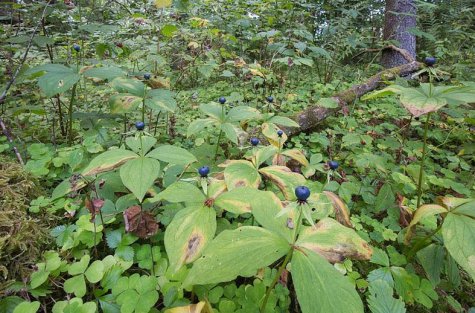Herb Paris – a very toxic herb
Photo Arne Ader
Translation Liis
Herb Paris-wood sorrel community
Herb Paris Harilik ussilakk Paris quadrifolia
Herb Paris prefers to grow on fertile soils, in broadleaf as well as mixed forests, also in wooded meadows. Fortunately it is not particularly common anywhere in Estonia and it is difficult to mistake it for any other plant.
The height of the herb Paris stays below half a metre. The stem of the plant is upright, in the top, on short stalks, four ovate leaves (seldom fewer or more). The plant is crowned by a blue-black flat berry – some covered by a wax layer, others glossy. It resembles a blueberry but I have never noticed herb Paris growing together with blueberries, and everyone, even a child, recognizes a blueberry.
The Estonian name of the herb Paris, ussilakk, meaning snake’s lick, has been understood by people of old as being licked by snakes whgich was believed to have turned the whole plant toxic. Ingenious interpretation.
The fruits and rhizome of the herb Paris are particularly toxic, but all parts of the plant are poisonous. They cause stomach pains, spasms of the intestines, nausea, dizziness and headache, even delirium. Paralysis of the cardiac and respiratory muscles may cause death. Herb Paris is known to have been used from the 16th century as a medical herb: in Europe for treatment of syphilis, in Russia for treatment of insanity. Homeopaths use a very diluted extract even today.
Everyone must know that the blue berry of the herb Paris must not be tested in the forest, not even only to taste it.









